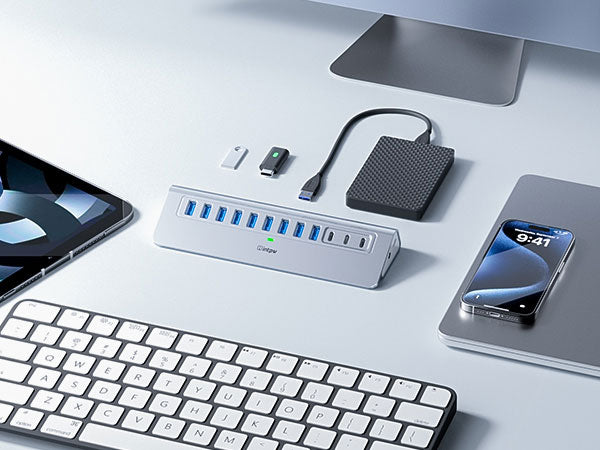
USB 4.0: Everything You Need to Know About the Future of Connectivity
, by USintpw, 6 min reading time

, by USintpw, 6 min reading time
Discover what makes USB 4.0 faster and smarter—learn its key features, benefits, and how it upgrades your tech experience.
In today's technology-driven world, it's more important than ever that devices connect seamlessly and efficiently. For example, USB technology is important when we transfer files, extend our displays, or charge our gadgets. USB 4.0 is the latest version of USB, and it's better than ever.
If you want to know what makes USB 4.0 different and how it can improve your technology experience, this guide will explain everything you need to know. We'll look at the main features, how it's different from older USB standards, and how it can solve common problems with connectivity.
USB 4.0 is the latest Universal Serial Bus (USB) standard version. It was introduced by the USB Implementers Forum (USB-IF) in 2019. It builds on Thunderbolt 3 technology, offering faster speeds, compatibility, and versatile capabilities.
USB 4.0 is designed to improve how your devices connect and communicate. It focuses on three things: high-speed data transfer, efficient power delivery, and the ability to handle multiple devices and protocols through a single cable.
USB 4.0 can transfer data at up to 40 billion bits per second. This is twice the speed of USB 3.2 (20 Gbps) and eight times faster than USB 3.0 (5 Gbps). If you work with large files, like high-definition videos or complex data sets, USB 4.0 makes transferring them much quicker.
USB 4.0 is different from earlier USB standards because it allows for simultaneous two-way data transfer. This means you can upload and download data at the same time without slowing down your connection.
USB 4.0 is backward compatible with USB 2.0, USB 3.x, and Thunderbolt 3. This ensures that your older devices still work seamlessly, though they may not take advantage of the higher speeds.
USB 4.0 uses different protocols, like PCIe (Peripheral Component Interconnect Express) and DisplayPort. This lets you use one USB-C port for different things, like connecting an external graphics card, a high-speed storage drive, or multiple monitors.
With USB 4.0, bandwidth is divided up based on what devices are hooked up. For example, if you connect a high-resolution monitor and an external hard drive, USB 4.0 will prioritize bandwidth to ensure the monitor displays smoothly while maintaining a fast data transfer rate for the hard drive.
USB 4.0 only uses the USB-C connector. This connector has a reversible design and is versatile. This makes it easier to manage cables and ensures that it works well with all devices.
To better understand USB 4.0’s capabilities, let’s compare it to previous USB standards:
If you’re a creative professional or someone who handles large amounts of data, USB 4.0 is a game-changer. For instance, transferring a 4K movie file or a high-resolution photo album takes just a few seconds. This saves you time and improves productivity.
USB 4.0 works with DisplayPort 2.0, so you can connect several 4K monitors or even an 8K display using one cable. This is especially useful for people who edit videos or design graphics and anyone who needs more space to work.
USB 4.0 can deliver up to 100 watts of power through the USB-C connector. This is enough to quickly charge laptops, tablets, and other high-power devices. Having one cable for both charging and data transfer helps you keep things neat and organized.
For gamers and VR fans, USB 4.0 provides fast, reliable connections. This makes sure that VR headsets, gaming devices, and external graphics cards work well.
With USB 4.0, you only need one cable to handle data, video, and power. You no longer need separate connections for different tasks, making your workspace cleaner and easier to manage.
People often confuse USB 4.0 with USB-C. Here's an easy explanation: USB 4.0 is a technology standard, while USB-C refers to the physical shape of the connector. USB 4.0 always uses USB-C connectors, but not all USB-C connectors support USB 4.0. To see if your device supports USB 4.0, check the product specifications or ask the manufacturer.
Yes, you'll need certified USB 4.0 cables to get the full benefits, like speeds of 40 Gbps. These cables also work with older USB standards.
Yes, USB 4.0 supports older USB devices. You can still use your existing peripherals, but they won’t benefit from the new standard’s speed and features.
You can check your device’s specifications or look for USB 4.0 branding on the packaging. Some devices may also include icons or labels near the USB-C ports.
Whether or not to upgrade depends on your needs. If you often transfer large files, work with high-resolution displays, or need fast charging, USB 4.0 might be worth thinking about. It's especially beneficial for creative professionals, gamers, and tech enthusiasts who need top-tier performance. If your current setup meets your needs, you might not need to upgrade immediately. However, as USB 4.0 becomes more common, buying devices that work with it now will ensure that your technology is ready for the future.
USB 4.0 is a big improvement over older USB technology. It's faster, smarter, and more versatile than older USB standards. If you want to get more done, set up your devices more easily, or just have a better experience with your technology, USB 4.0 can help. As more devices adopt USB 4.0, it will become a standard feature in everyday technology. By learning about its features and advantages, you can decide whether to upgrade and enjoy a more efficient, connected life.

Subscribe to our emails